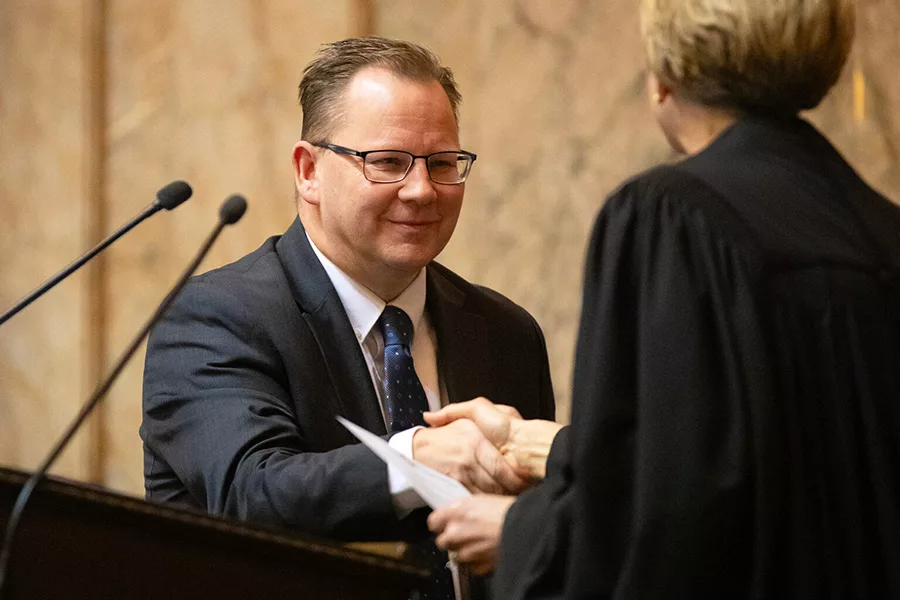
Home » Reykdal says Washington risks lawsuit if school funding isn’t hiked
Reykdal says Washington risks lawsuit if school funding isn’t hiked
The state boosted spending to comply with a ruling in the landmark McCleary case, but the public schools chief says it hasn’t kept up.

Superintendent of Public Instruction Chris Reykdal is sworn in on Wednesday, Jan. 15, 2025, at the Washington State Capitol in Olympia, Wash. Reykdal was first elected to the job in 2016.
Photo by Ryan Berry/Washington State StandardJanuary 17, 2025
Superintendent of Public Instruction Chris Reykdal warned Jan. 16 that Washington is not living up to its constitutional obligation to cover the cost of basic education and faces the “very serious possibility” of landing back in front of the state Supreme Court to explain why.
Seven years ago, in the landmark case known as McCleary, justices ruled the state had complied with the court’s order to ensure ample funding for basic education. But the state’s been backsliding since, Reykdal said, and no longer provides enough money to local school districts to keep pace with rising costs.
“The court didn’t say you’re done. Our fiscal situation is getting perilous in a lot of places,” he said, adding “it is a very serious possibility” the state could be hauled into court again for not meeting its school funding obligations.
Jared Kink, president of the Everett Education Association, a unit of the Washington Education Association, agreed a courtroom reckoning looms if the Legislature and governor don’t step up.
“The McCleary decision on funding wasn’t a static number. The Legislature has not adapted to the increasing costs that educators are experiencing in schools,” he said.
Reykdal made his comments Jan. 16 as he provided a status check on Washington’s 1.1 million-student public school system that he’s overseen since 2017.
He spoke about trends in student enrollment and academic achievement but he devoted a large portion of his 45-minute talk to the need to tackle major cost-drivers districts face: special education, transportation, and materials, supplies and operating costs, also known as MSOC.
Reykdal estimated it would take $2 billion in the next budget to collectively cover the gap between what the state now provides districts for each of those areas and the actual amount they spend.
About half is for special education and would enable lifting a cap on state funding for special education programs and covering these services for those up to age 22. Reykdal also wants to track increases in enrollment of students in need of special services.
Close to $140 million is needed to provide reliable transportation to and from school for all students, including those with special needs, those who are homeless, and those in foster care.
Materials, supplies and operating costs are up due to spiking prices, including insurance premiums, natural gas rates and utility charges.
But pumping more money toward schools is a big ask for lawmakers and Gov. Bob Ferguson who will be focused on filling a large budget hole.
“I understand people talk about ‘this is a tough year’. Every year is a tough year,” Reykdal said. “We do not want to find ourselves back in court.”
The challenge, he continued, is to make sure Democrats and Republicans consider long-term goals in education investment not just the “crisis of the moment in their budget.”
In the current two-year operating budget, Washington is spending roughly $30.6 billion of the general fund — the cache of state tax dollars used to fund day-to-day operations — on public schools, he said. That works out to roughly 43%, down from the high-water mark of over 50% in 2019, the year after McCleary was resolved.
“Setting a goal like 50% again, gives us something measurable to shoot for, and I think it’s tangible,” Reykdal said.
Ferguson has called the 43% level “unacceptable” and vowed to boost the percentage in the next budget. He has not said how. And he has been silent on what increases he might support for special education, MSOC and transportation.
He has endorsed spending $240 million to provide free breakfast and lunch for students. Ferguson also endorsed former governor Jay Inslee’s proposal to save $250 million by not paying bonuses to teachers earning National Board certification.
Reykdal also called on lawmakers to allow local school districts to raise greater amounts of money from voter-approved local levies, also known as enrichment levies.
The cap on how much districts could seek from voters was cut nearly in half following the McCleary decision. Lawmakers reasoned that if the state provides more funding, districts should not be able to collect as much from local taxpayers.
This story is republished from the Washington State Standard, a nonprofit, nonpartisan news outlet that provides original reporting, analysis and commentary on Washington state government and politics.
Latest News Education & Training
KEYWORDS January 2025
Related Articles
Related Products





